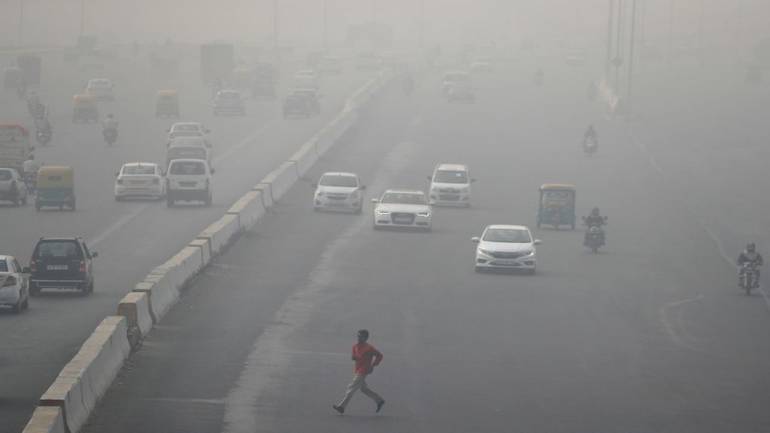
Weather, not firecracker ban, helped Delhi's air quality this Diwali

Despite a 30 per cent drop in incidents of bursting firecrackers this Deepavali as against last year, the air quality in Delhi plunged to the ‘very poor category’ (AQI 323) on Tuesday (October 25). At the time of filing the copy (5 pm), the air quality was back in the ‘poor category’ (AQI 299).
Delhi Chief Minister Arvind Kejriwal lauded the residents for their efforts to curb pollution in the city. The condition, however, was relatively better than the previous years due to favourable meteorological conditions that diluted the effect of many residents flouting a firecracker ban and stubble burning.
Also read: Delhi-NCR left gasping again as steps to check pollution find few takers
The Aam Aadmi Party (AAP) leadership has refrained from directly answering questions on growing cases of farm fire incidents in Punjab, but has blamed the Centre for its “blunt refusal to provide a cash incentive to farmers in Punjab for not burning crop residue”.
Worrying PM levels
Data from the Delhi Pollution Control Committee showed that on Diwali night, the particulate matter (PM) concentrations rose considerably with lighting fireworks – which was a clear violation of the ban, in place till early next year. PM 2.5 level reached a figure that was as much as 15 times and PM 10 level around 10 times the 24-hour standard.
Also read: Delhi air quality ‘severe’ as residents defy ban on firecrackers on Diwali
At most places in Delhi, the PM 2.5 concentration hit 750-800µg/m3 at midnight, up from 75 µg/m3 at 6 pm on Monday. “The 24-hour standard for PM 2.5 according to the National Ambient Air Quality Standards is 60 µg/m3,” said Vijay Kumar Soni, head of the environment monitoring and research centre at the India Meteorological Department (IMD)
Efficacy of complete ban
Replying to a question on whether the firecracker ban had been effective, a police official in Delhi’s south district, under sub-division CR Park police station, on condition of anonymity said, people may have procured them from Sadar Bazaar market. Most of the firecrackers were purchased well before the ban was announced on September 7, he added. The reader of the same station added that although written complaints were not registered, people had dialled Police Control Room vans to file complaints.
He also added that police managed to register complaints against online sellers willing to deliver items to the buyer’s house. “Additionally, people go to Noida and Gurugram to pick up crackers. Therefore, it becomes extremely difficult to monitor the ban on the ground,” said the police official. Delhi environment minister, Gopal Rai, while announcing the ban last month, had said that online portals will also be covered in the ban.
Collateral damage
Farm fires have a great impact on Delhi’s overall air quality. Punjab has reported a nearly three-fold jump in farm fire incidents in the last nine days, with the total number of such cases reaching 2,625 so far this season, according to various reports. From September 15 till October 10 this year, the state has in fact witnessed 718 stubble-burning incidents.
This does not bode well for Delhi, which every year suffers hazardous levels of air pollution as wind blows the smoke and pollutants towards the capital city.
Also read: Delhi’s air quality turns ‘very poor’ on Diwali night; firecracker ban flouted
Centre’s approach
Meanwhile, the Commission for Air Quality Management (CAQM) in Delhi-NCR set up in 2021 through a bill, acts as an overarching body to consolidate all monitoring bodies, and bring them under one platform so that air quality management can be carried out in a more comprehensive, efficient and time-bound manner. With the setting up of the commission, the Centre also sought to relieve the Supreme Court from having to constantly monitor pollution levels through various cases.
The powers of the CAQM supersede that of any other body in matters of air pollution. Thereby, in cases where conflict may arise between orders or directions issued by the other state governments, state pollution control boards or even the Central Pollution Control Board, the orders of the commission will prevail.
With authorities foreseeing the deterioration in air quality during Diwali and the following days, the CAQM in Delhi-NCR had directed the authorities to enact stage 2 of the Graded Response Action Plan (GRAP), which includes banning the use of diesel generators, coal and firewood in hotels, restaurants and open eateries.
Forecast for a week
Speaking exclusively to The Federal, Vijay Kumar Soni, head of the environment monitoring and research centre at IMD said that the air quality in the capital will remain in the ‘poor to very poor category’ as atmospheric conditions are far more favourable this year.
This year, a delay in peak stubble burning incidents and the fact that Deepavali fell in October, when temperatures are warmer, helped control air pollution, said Soni.
Speaking to The Federal, Polash Mukherjee, lead on air quality at the Natural Resources Defence Council, India said that if Delhi has to ensure a total ban on firecrackers, cooperation from other neighbouring states are equally crucial. Haryana had imposed a ban on the manufacturing, sale and use of all kinds of firecrackers except for green crackers, while the Punjab government had given a two-hour window for bursting firecrackers on Deepavali.


